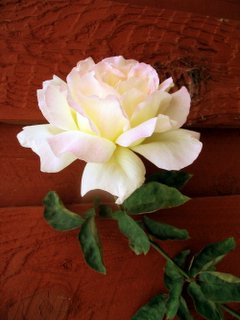
This is my contribution to the Flower Fest - The A - Z of Flowers for the Letter I.

The Picture is an Iris painted using Acrylics.
The genus is widely distributed throughout the north temperate zone. Their habitats are considerably varied, ranging from cold regions into the grassy slopes, meadowlands, stream banks and deserts of Europe, the Middle East and northern Africa, Asia and across North America.
They are perennial herbs, growing from creeping rhizomes (rhizomatous irises), or, in drier climates, from bulbs (bulbous irises). They have long, erect, flowering stems, which may be simple or branched, solid or hollow, and flattened or have a circular cross-section. The rhizomatous species usually have 3-10 basal, sword-shaped leaves growing in dense clumps. The bulbous species have cylindrical basal leaves.
The inflorescences are fan-shaped and contain one or more symmetrical, six-lobed, slightly fragrant flowers. These grow on a pedicel or lack a footstalk. The three sepals are spreading or droop downwards. They expand from their narrow base into a broader limb (= expanded portion), often adorned with lines or dots. The three, sometimes reduced, petals stand upright, partly behind the sepal bases. Some smaller iris species have all six lobes pointing straight outwards. The sepals and the petals differ from each other. They are united at their base into a floral tube, that lies above the ovary. The styles divide towards the apex into petaloid branches (see pollination, below).
The iris flower is of special interest as an example of the relation between flowering plants and pollinating insects. The shape of the flower and the position of the pollen-receiving and stigmatic surfaces on the outer petals form a landing-stage for a flying insect, which in probing the perianth for nectar, will first come in contact of perianth, three with the stigmatic stamens in one whorl surface which is borne and an ovary formed of three carpels. The shelf-like transverse projection on the inner whorl under side of the stamens, which is beneath the over-arching style arm below the stigma, so that the insect comes in contact with its pollen-covered surface only after passing the stigma, while in backing out of the flower it will come in contact only with the non-receptive lower face of the stigma. Thus, an insect bearing pollen from one flower, will in entering a second, deposit the pollen on the stigma, while in backing out of a flower, the pollen which it bears will not be rubbed off on the stigma of the same flower.

12 COMMENTS:
Mythreyee, Lovely painting. Beautiful...nice work lady!!!
Hi Mythree.... Lovely blog..... beautiful paintings and awesome food!!!!! Like you I am also a foodie and a painter as well!!!!!! Check my blogs. I am blogrolling you if you dont mind :)
www.mykhazanaofrecipes.wordpress.com
www.onmycanvas.wordpress.com
woooow mythy
no words to say
wonderful painting
u hands just play with colors
looks lovely
thanks for this wonderful treat to eyes mythy
Wow Mythreyee...You have touched me alot ..becoz my favourite colour is lavander......
Excellent pictures with painting dear
Mythreyee! Thank you for yet another beautiful entry to the Flower Fest. I didn't care for iris till we moved and I found I had a bunch in my backyard. I realized how much I enjoyed when they were attacked by a white bug! You've captured the colors beautifully!
Mythreyee,
This is a wonderful painting! Great work!
Mythreyee - Another good one from you!
Mythreyee - Another good one!
Hai Mythree
U are amazing!! never seen anyone painting so beautifully!!woh!!!!
Seema: Thanks.
Coffee: Sure, will visit your sites. and thanks for the sweet words and thanks for dropping by.
Jaya:Thanks.
Usha: Thanks.
Manisha: Thanks a lot for conducting this wonderful flowerfest. Because of this, I have started my painting hobby again after many years.
Sree: Thanks.
Nature & Me: Thanks.
Paddukoti: Thanks.
Mythreyee! I hope you find time in your busy schedule to submit an entry for J! Looking forward to it!
Hi Mythreyee, I have added you to my blog roll...but guessing which part of TN you are???
Post a Comment